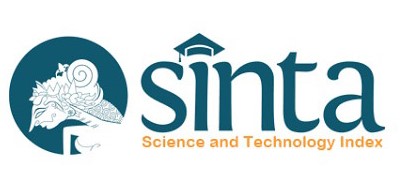Delta Inferior Vena Cava Index Correlated with Mean Arterial Pressure (MAP) in Spinal Anesthesia
Abstract
Background: Spinal anesthesia has become an alternative to general anesthesia. However, spinal anesthesia has the most common side effects including, bradycardia and hypotension. The aim of this study was to determine the relationship between changes in the inferior vena cava index (delta inferior vena cava index) to changes in mean arterial pressure in spinal anesthesia.
Methods: This study was an observational pre-post test study in thirty-two patients who received spinal anesthesia. The inferior vena cava index (inferior vena cava collectibility index and caval-aorta index) was measured before and after spinal anesthesia (5 and 10 minutes after onset). Data were analyzed using the Kolmogorov Smirnov test, Shapiro-Wilk test, T-test, and correlation test with α=5%
Result: There was a significant difference in mean arterial pressure (MAP), delta inferior vena cava collectibility index (D-IVC-CI), and delta caval-aorta index (D-CAo-I) before and after spinal anesthesia. D-IVC-CI and D-CAo-I are significantly correlated with MAP. The correlation between D-IVC-CI and MAP had R = -0.371 (P <0.05) at 5 minutes post-anesthesia, while D-CAo-I and MAP had R = 0.472 (P <0.05) at 10 minutes post-anesthesia.
Conclusion: The delta inferior vena cava index is correlated with the mean arterial pressure (MAP) value in spinal anesthesia.
Keywords
Full Text:
PDFReferences
Chin A, Zundert A. Spinal Anesthesia. In: Hadzic’s Textbook Of Regional Anesthesia And Acute Pain Management. Second Edi. New York: The McGraw-Hill; 2017:328-363.
Ceruti S, Anselmi L, Minotti B, et al. Prevention of arterial hypotension after spinal anaesthesia using vena cava ultrasound to guide fluid management. Br J Anaesth. 2018;120(1):101-108. doi:10.1016/j.bja.2017.08.001
Laksono RM I. Fentanyl Intratekal Mencegah Menggigil Pasca Anestesi Spinal pada Seksio Sesaria Intrathecal Fentanyl for Prevention of Post Anesthetic Shivering in Caesarean Section. J Kedokt Brawijaya. 2012;27(1):51-55.
Hyderally H. Complications of spinal anesthesia. Mt Sinai J Med. 2002;69(1-2)):55-6.
Butterworth JF, Mackey DC, Wasnick JD. Spinal, Epidural, & Caudal Blocks. In: Morgan & Mikhail’s Clinical Anesthesiology. Sixth Edit. New York: The McGraw-Hill; 2018:1526.
Norris M. C. Neuroaxial Anesthesia. In: Clinical Anesthesia. Eighth Edi. Philadelphia: Walters Kluwer; 2017.
Brennan JM, Blair JE, Goonewardena S, et al. Reappraisal of the Use of Inferior Vena Cava for Estimating Right Atrial Pressure. J Am Soc Echocardiogr. 2007;20(7):857-861. doi:10.1016/j.echo.2007.01.005
DeMers D WD. Physiology, Mean Arterial Pressure. In: StatPearls [Internet]. Treasure Island (FL): StatPearls Publishing;
Fang JC, O’Gara P. Braunwald’s Heart Disease A Textbook Of Cardiovascular Medicine.; 2012.
Ellis H, Lawson A. Anatomy for Anaesthetists. Ninth Edit. United Kingdom.: Wiley Blackwell; 2014.
Guyton AC and HJE. Overview of the Circulation, Medical Physics of Pressure, Flow, and Resistance. In: Textbook of Medical Physiology. Eleventh E. Philadelphia: Elsevier Saunders; 2006:161.
Kam, P. and Power I. Cardiovascular Physiology. In: Principles of Physiology for the Anaesthetist. New York: CRC Press; 2015:154-157.
Meng L, Yu W, Wang T, Zhang L, Heerdt PM, Gelb AW. Provisional Considerations Based on a Comprehensive Literature Review. 2018:806-817. doi:10.1161/HYPERTENSIONAHA.118.11688
Fuster, V. et al. . The History, Physical Examination, and Cardiac Auscultation. In: Hurst’s The Heart. 14 th Edit. New York: McGraw Hill; 2017.
Salama ER, Elkashlan M. Pre-operative ultrasonographic evaluation of inferior vena cava collapsibility index and caval aorta index as new predictors for hypotension after induction of spinal anaesthesia: A prospective observational study. Eur J Anaesthesiol. 2019;36(4):297-302. doi:10.1097/EJA.0000000000000956
Vinayagam S, Joseph C, Dhanger S. Caval aorta index as a predictor of hypotension after spinal anesthesia. Eur J Anaesthesiol. 2020;37(1):61. doi:10.1097/EJA.0000000000001079
Rahman NHN, Ahmad R, Kareem MM, Mohammed MI. Ultrasonographic assessment of inferior vena cava/abdominal aorta diameter index: a new approach of assessing hypovolemic shock class 1. Int J Emerg Med. 2016;9(1):1-6. doi:10.1186/s12245-016-0101-z
Kam P, Power I. Cardiovascular Physiology,. In: Principles of Physiology for the Anaesthetist. Third Edit. New York: CRC Press; 2015:154-157.
Pasquero P, Albani S, Sitia E, et al. Inferior vena cava diameters and collapsibility index reveal early volume depletion in a blood donor model. Crit Ultrasound J. 2015;7(1):1-7. doi:10.1186/s13089-015-0034-4
DOI: http://dx.doi.org/10.21776/ub.jap.2021.002.02.04
Refbacks
- There are currently no refbacks.

This work is licensed under a Creative Commons Attribution 4.0 International License.









.png)

